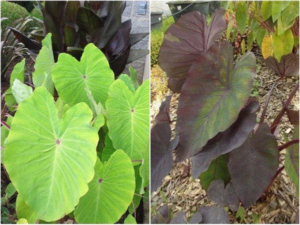Dr. Jared Barnes and colleagues at Stephen F. Austin University in Nacogdoches, Texas, trialed 46 Colocasia species/cultivars over two years to determine what performed best over a two-year growing period. First of all, Nacogdoches is in east Texas (Zone 8-b) and typifies the upper coastal plain, stretching from there east to South Carolina. Cultivars were grown in full sun and ratings were taken every two weeks during the growing season on a 1 (poor) to 5 (perfect) scale.
Only two cultivars earned a ranking above 3.5 in both of the trial years: Colocasia esculenta Madiera is commonly referred to as elephant ears, however, it has two traits that set it apart from the green giants you may be thinking of. First of all, Madiera about a third to half the size of the green forms of C. esculenta. Secondly, the foliage is a deep purple, making it a very striking garden plant. Listed as Zone 7 hardy, gardeners farther north can grow it, harvest tubers in the fall, store the tubers in a cool, dry location in a paper bag, and replant the following year.
The second outstanding performer is C. esculenta Red-Eyed Gecko (a Plants Nouveau introduction). It grows about 4-feet tall and wide boasts chartreuse foliage with a red spot in the upper side of foliage where the petiole is attached on the underside of the leaf. Variety listed as hardy to Zone 8.
*Information and photos reprinted with permission from Dr. Michael Chappell published 8/10/2018 edition of Ball Publishing, Nursery & Landscape Insider e-newsletter editor.


 Posted in
Posted in 
